
Image description: Stars have a finite age and thus a finite lifespan. Their light source is too ephemeral to saturate space with their radiation. Credit: Stellarium image
"The night is only night for us. It is our eyes that are dark." This quote from René Barjavel (1911-1985) in the science fiction novel "The Night of Times" could be the answer to the question: Why is the night sky dark?
Each of us might simply admit that the cause of the dark night is the absence of the Sun above the horizon, but this is not a good answer.
Indeed, the night is dark, and before the 20th century, the universe was assumed to be static, infinite, and populated with stars. For several centuries, these two ideas would remain paradoxical!
Evidently, the night has always been dark. But if the universe were infinite in space and time, no matter which direction you looked, your line of sight should intersect with a star, even a very distant one. The sky should therefore appear as bright as the Sun everywhere. However, we find that the night is essentially dark!
This assertion, known as Olbers' paradox, was studied in 1826 by Heinrich Olbers (1758-1840). However, the question had been posed since 1576 by Thomas Digges (1546-1595) in a publication where he distributed stars randomly throughout the celestial sphere. This view of the sky led him to ask, "Why do this infinity of stars not make the night sky bright?" His answer was that most of them were too far to be seen, but this is not a good answer.
In 1610, in his supportive letter to Galileo "Dissertatio cum Nuncio Sidereo" (Conversation with the Celestial Messenger), Johannes Kepler (1571-1630) seems to dismiss the notion of an infinite Universe.
Although many astronomers have pondered this question, the resolution of this paradox remained unresolved for three centuries.
Edmond Halley (1656-1742) and Jean-Philippe Loys de Chéseaux (1718-1751) provided a mathematical answer to this question. De Chéseaux, in 1744, inspired by Halley's work, imagined the sky as a series of concentric spherical layers of constant thickness centered on the observer. Thus, the number of stars in each layer is proportional to its surface area, hence the square of its radius. In other words, at a distance 2d there are 4 times more stars, at a distance 4d there are 16 times more stars, etc.
However, the brightness of a star is inversely proportional to the square of its distance. In other words, if a star has a certain brightness at a distance d, at a distance 2d, it is 4 times less bright. The flux from a star decreases as the inverse of the square of the distance ƒ(e)=L/4πr² (L=luminosity).
Thus, if the universe is infinite, we have an infinity of layers with the same brightness, and the observer receives the same amount of light energy from each layer. The total brightness should be infinite.
We now know that this assertion is incorrect because stars have a finite lifespan.
Thus, light from stars could be blocked by interstellar dust and gas. This explanation is also incorrect because the medium would gradually heat up by absorbing light and become as bright as the surface of a star. This does not resolve Olbers' paradox.
Indeed, in 1848 Edgar Allan Poe (1809-1849) intuitively presented this hypothesis in his essay on the material and spiritual universe titled "Eureka."
Indeed, the speed of light being finite (as known at that time), it takes a certain time to reach us. But this hypothesis is not correct in an infinite and eternal Universe. If the Universe is eternal, no matter how long it takes for light to reach us, it should already dazzle us.
In 1901, William Thomson, known as Lord Kelvin (1824-1907), demonstrated that in a transparent, uniform, and static universe, uniformly filled with stars, the finite age of stars prevented the visibility of distant stars.
To resolve this simple paradox of the black night, it was necessary to completely revise our conception of the Universe.
Behind the story of Olbers' paradox lay a disturbing cosmic reality from which several concepts emerged at the end of the 20th century.
- The Universe has not always existed; it has a history and is 13.77 billion years old.
- The speed of light (300,000 km/s) is finite, and thus the Universe has a finite size. In 13.77 billion years, photons have traveled 13.77 billion light-years.
- Stars have a finite age and thus a finite lifespan. Their light source is too ephemeral to saturate space with their radiation.
- The Universe is expanding at an accelerated rate. The sky is getting darker as light from distant galaxies is increasingly redshifted (Doppler effect). The most distant galaxies, losing their brightness, are extremely difficult to observe.
All these hypotheses must be combined to solve the Dark night paradox.
"The night is only night for us. It is our eyes that are dark."
In infrared observations, distant galaxies reveal gigantic glows that illuminate interstellar dust. For every point in the sky, our line of sight intersects the infrared flux of a galaxy.
But the most original brightness is found in the microwaves. This cooled fossil radiation is observed in all directions of the sky.

Image description: This complete map of the CMB (Cosmic Microwave Background) shows temperature fluctuations in the primitive Universe when it became transparent ~380,000 years after the Big Bang. The maximum temperature difference between the cold blue regions and the hot red regions is about 0.0001 °C. Credit: Montage of images taken by Planck (ESA satellite) over 9 years.